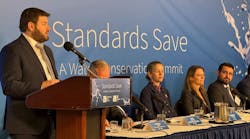WASHINGTON, DC — As part of its first annual Water Conservation Summit, hosted at the National Press Club in Washington, DC, the International Code Council today findings of a new report from the University of Miami, underscoring the critical need for municipalities to adopt updated water conservation standards contained in the 2021 International Water Conservation Code Provisions (IWCCP). The Code Council partnered with experts from University of Miami to issue the report, titled Water Conservation and Codes: Leveraging Global Water-Efficient Building Standards to Avert Shortfalls.
The full University of Miami report, along with an executive summary, is available for download at: https://www.iccsafe.org/pmg/worldwater/all-events/.
Rethinking Scale
While many water conservation efforts focus on utility-scale solutions that leverage reclamation, desalinization, and storage projects, new research in the report being released by the Code Council shows that decentralized efforts at the individual building level can, in the aggregate, be equally impactful.
Water experts from across the federal government and water-related utilities and services, including the report’s lead researcher, delivered remarks from the Summit during a live news conference and panel discussion. Based on the report and other observations, there was consensus on the importance of strengthening water policy at all levels, and adopting modern solutions to water conservation in the US.
Meaningful Savings are Possible
“Given that nearly two-thirds of the world’s population experience periods of severe water scarcity, and some 700 million people could be displaced by intense water scarcity by 2030, conservation solutions at all levels of government are critical,” said International Code Council Chief Executive Officer Dominic Sims, CBO; “The rapid adoption of modern building standards is imperative, and the research we are publishing today shows that meaningful water savings are possible in the very near term. We are able see the results in our own back yard, here in the U.S.”
Lead Report Author Dr. Esber Andiroglu, Dept. of Civil, Architectural and Environmental Engineering and School of Architecture, University of Miami, said: “Challenges from climate impacts and urban sprawl require innovative solutions for water management. The report we are issuing today provides a comprehensive roadmap for decision makers. Conservation experts have long recognized the need for a modern, cost-efficient code governing the impact of buildings and structures on the environment. The International Water Conservation Code Provisions (IWCCP) promotes water conservation through safe and sustainable construction practices, offering a clear path for achieving this goal.”
Methodology
After determining baseline potable and non-potable water use, the report examines the potential water savings for one-and two-family dwellings in Phoenix, Las Vegas, Houston, and Des Moines based on adoption of four different water conservation strategies within the IWCCP: 1) adoption of more efficient plumbing fixtures; 2) rainwater harvesting, treatment, storage, and reuse; 3) graywater treatment, storage, and reuse ; and 4) HVAC condensate catchment, treatment, storage, and reuse.
In Houston, optimized total water savings from all four strategies when integrated into new home construction alone is projected to be 23.3 billion gallons by 2029. In Phoenix, water savings are projected to be 7.3 billion gallons annually, with 1.7 billion gallons saved in Las Vegas and 1.57 billion gallons in Des Moines.
Across all the cities examined, the cost of one more water conservation approach is similar to the current cost per gallon of water consumption.
The Time to Act is Now
Over the next 50 years, nearly half of America’s freshwater basins may not be able to meet the monthly water demand, with shortages anticipated in the central and southern Great Plains, the Southwest, and central Rocky Mountain states, as well as parts of California, the South, and the Midwest.


